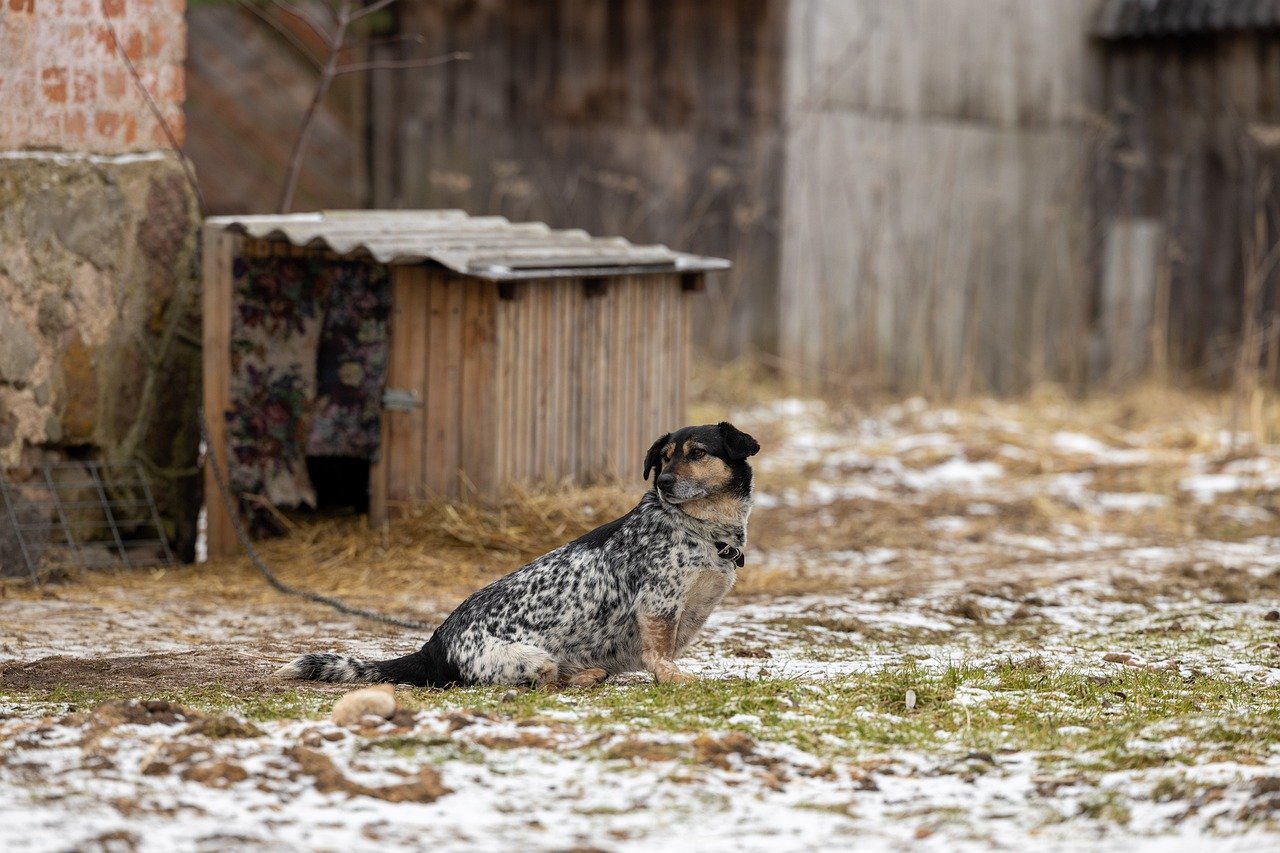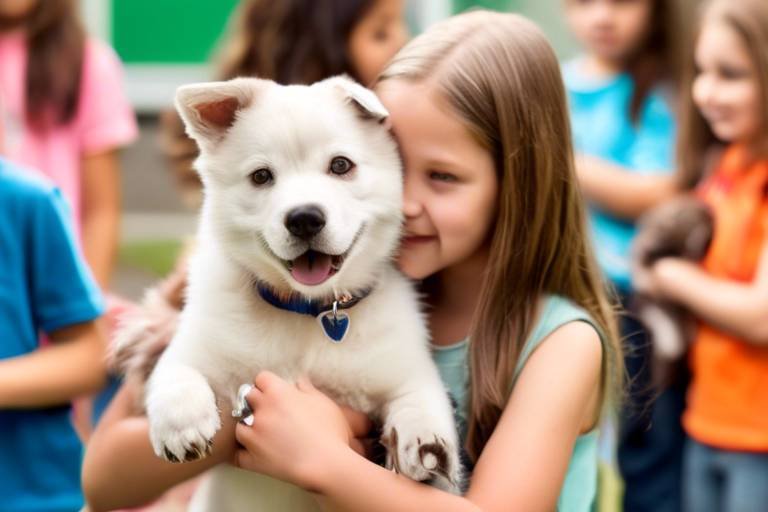How to Address Common Misconceptions About Rescue Pets
When it comes to adopting a furry friend, many people are overwhelmed by the sheer number of choices available. But amidst the sea of options, one route stands out as particularly noble and fulfilling: adopting a rescue pet. However, despite the many advantages of bringing a rescue animal into your life, there are still numerous misconceptions that can deter potential adopters. This article aims to shine a light on these myths and reveal the heartwarming truth behind rescue pets. By debunking these misconceptions, we not only encourage more people to consider adoption but also celebrate the joy and companionship that rescue animals can bring into our lives. So, let's dive in and explore the reality of rescue pets and why they deserve a loving home.
Rescue pets come from various backgrounds, often facing challenges that can lead to misunderstandings about their behavior and needs. Many of these animals have experienced abandonment, neglect, or abuse, which can understandably create a sense of wariness in potential adopters. However, adopting a rescue pet is not just about saving an animal; it's about enriching your own life with unconditional love and companionship. When you choose to adopt, you open your heart and home to a creature that has been through tough times, offering them a second chance at happiness. Understanding the journey of these animals is crucial to appreciating the bond that can develop once they find a loving family.
One of the most common myths surrounding rescue pets is the belief that they come with inherent behavioral problems. Many people assume that because these animals have been through difficult situations, they will be difficult to train or manage. However, this couldn't be further from the truth! With the right training, patience, and love, rescue pets can thrive and become wonderful companions. It's essential to remember that every pet, whether adopted or bought from a breeder, requires proper training and socialization. The idea that rescue pets are problematic is simply a misconception that overlooks the potential for growth and improvement.
While it’s true that some rescue pets may come with behavioral challenges, understanding these issues can help potential adopters prepare for a successful transition. Common behavioral challenges may include:
- Fearfulness: Many rescue pets may exhibit fear-based behaviors due to past trauma.
- Separation anxiety: Some pets may struggle with being alone, leading to destructive behaviors.
- Lack of socialization: Pets that haven't been exposed to various environments may be skittish or reactive.
Recognizing these challenges is the first step in addressing them effectively. With time and patience, you can help your rescue pet overcome these hurdles and develop into a well-adjusted member of the family.
Effective training techniques can transform a rescue pet's behavior. Positive reinforcement is one of the most successful methods, where desirable behaviors are rewarded with treats, praise, or playtime. This encourages the pet to repeat those behaviors. Additionally, consistency is key; establishing a routine can help your rescue pet feel more secure and understand what is expected of them. Remember, patience is essential. Each pet learns at their own pace, and celebrating small victories can make the training process enjoyable for both of you.
Socialization is crucial for rescue pets to thrive. Exposing your new companion to different environments, people, and other animals can help alleviate fears and build confidence. Start slowly; take them on short outings to parks or pet-friendly stores. Gradually introduce them to new experiences, ensuring that each encounter is positive. This process not only helps your pet adjust but also strengthens the bond between you and your furry friend.
Highlighting success stories can inspire potential adopters. There are countless heartwarming examples of rescue pets who have thrived in loving homes. For instance, consider the story of Bella, a timid dog who was rescued from a shelter. With love and patience, her new family helped her overcome her fears, and now she is a playful and affectionate companion. Stories like Bella's showcase the incredible transformations that rescue pets can undergo, proving that with the right environment, they can flourish and bring joy to their families.
Another common misconception is that the adoption process is complicated and time-consuming. Many people perceive it as a cumbersome journey filled with paperwork and hurdles. However, the truth is that adopting a rescue pet can be a straightforward and rewarding experience. Most shelters and rescue organizations aim to make the process as smooth as possible, often providing guidance and support throughout. Remember, the goal is to find a perfect match for both the pet and the adopter, ensuring a happy future together.
Understanding the steps involved in adopting a rescue pet makes the process less daunting. Here’s a quick breakdown of the typical adoption journey:
- Research: Look for local shelters or rescue groups that align with your values.
- Application: Fill out an adoption application, providing information about your lifestyle and preferences.
- Meet and Greet: Spend time interacting with potential pets to see if there’s a connection.
- Home Visit: Some organizations may conduct a home visit to ensure a safe environment.
- Adoption Fee: Pay the adoption fee, which often covers vaccinations and spaying/neutering.
- Bring Your Pet Home: Congratulations! Welcome your new family member!
Post-adoption support is essential for new pet owners. Many shelters and rescue organizations offer resources to help families adjust and ensure a smooth transition for their rescue pets. This can include access to training classes, behavioral consultations, and community support groups. Remember, you’re not alone in this journey; there are countless resources available to assist you as you embark on this exciting new chapter with your rescue pet.
Q: Are rescue pets more likely to have health issues?
A: Not necessarily! Many rescue pets are thoroughly vetted before adoption, and shelters often provide information on their health history.
Q: Can I find specific breeds in rescue shelters?
A: Yes! Many rescue organizations specialize in specific breeds, and you can often find purebred animals in need of homes.
Q: What if I encounter behavioral issues after adoption?
A: It's important to remember that any pet may have behavioral challenges. Seeking professional training or consulting with your shelter can help address these issues.

Understanding Rescue Pets
When we talk about rescue pets, we're diving into a world filled with stories, challenges, and heartwarming transformations. These animals often come from diverse backgrounds, whether they were strays, surrendered by their owners, or rescued from abusive situations. Each pet carries its own unique history, which can sometimes lead to misunderstandings about their behavior and needs. It's essential to recognize that adopting a rescue pet is not just about giving an animal a home; it's about understanding their journey and providing a loving environment where they can thrive.
One common misconception is that rescue pets are inherently problematic or damaged. However, this couldn't be further from the truth! Many rescue animals are simply victims of circumstances beyond their control. They may have been abandoned or neglected, but with the right support and love, they can blossom into wonderful companions. Imagine a flower that has been deprived of sunlight; once it gets the proper care, it can bloom beautifully. Similarly, rescue pets need nurturing and patience to reveal their true potential.
It's also important to note that rescue pets come in all shapes, sizes, and personalities. From playful puppies to wise old cats, there’s a perfect match for everyone. Adopting a rescue pet means you’re not just saving a life; you're also gaining a loyal friend who will shower you with love and affection. Think of it as embarking on an adventure where you both learn and grow together, creating memories that last a lifetime.
In understanding rescue pets, we must also acknowledge the emotional and psychological challenges they might face. Many have experienced trauma, which can manifest in various ways, such as anxiety or fearfulness. However, with the right approach, these issues can often be addressed effectively. For instance, a rescue dog may initially shy away from strangers, but with consistent training and positive reinforcement, they can learn to trust and feel safe in their new environment.
To further illustrate the importance of understanding rescue pets, here are some key points to consider:
- Backgrounds Vary: Each rescue pet has a unique story that shapes their behavior.
- Not All Are Problematic: Many rescue animals are well-adjusted and just need a second chance.
- Emotional Support: Rescue pets can provide immense emotional support to their owners.
- Potential for Growth: With love and training, rescue pets can overcome their past challenges.
Ultimately, understanding rescue pets is about empathy and commitment. When you choose to adopt, you're not just providing a home; you're becoming a vital part of their healing journey. So, if you're considering bringing a rescue animal into your life, remember that patience and love can work wonders. You're not just saving a pet; you're enriching your own life in ways you might never have imagined!

Myth: Rescue Pets Are Problematic
When it comes to rescue pets, there's a common belief that these animals come with a host of behavioral issues. This misconception can deter potential adopters from giving these loving creatures a chance. However, it's crucial to understand that a pet's past does not dictate its future. Just like people, animals can learn, grow, and change with the right guidance and support. The truth is, many rescue pets are simply victims of circumstance rather than inherently problematic. They may have faced neglect, abuse, or just a lack of training in their previous environments, which can lead to certain behaviors that seem concerning at first glance.
It's essential to recognize that many of these behaviors can be addressed through proper training and socialization. For instance, a rescue dog that appears shy or fearful may just need a little time and patience to adjust to a new home. With the right approach, these challenges can be transformed into opportunities for bonding and growth. In fact, many rescue pets thrive in loving homes, revealing their true personalities once they feel safe and secure. So, rather than viewing rescue pets as problematic, consider them as animals with unique stories that can flourish with the right care.
Understanding the typical behavioral challenges that rescue pets may face is vital for potential adopters. Some common issues include:
- Fear and Anxiety: Many rescue pets have experienced trauma, leading to anxiety in new situations.
- House Training Issues: Some pets may not have been house-trained properly, leading to accidents.
- Socialization Deficits: Rescue animals might not be accustomed to interacting with other pets or people.
These challenges can seem daunting, but they are not insurmountable. With dedication and the right training methods, these pets can become well-adjusted members of your family.
Effective training techniques can work wonders in transforming a rescue pet's behavior. Techniques such as positive reinforcement, where pets are rewarded for good behavior, can create a strong bond between the pet and owner. Consistency is key; using the same commands and routines helps the pet understand what is expected of them. Additionally, enrolling in obedience classes can provide structured learning and socialization opportunities, making the process enjoyable for both the pet and the owner.
Socialization is another critical aspect of helping rescue pets thrive. By gradually exposing them to different environments, people, and other animals, you can help alleviate their fears and build their confidence. Start with short outings and gradually increase exposure as they become more comfortable. The goal is to create positive experiences that reinforce their understanding of the world around them. Remember, a well-socialized pet is often a happier pet!
To inspire potential adopters, it’s essential to highlight the success stories of rescue pets who have thrived in loving homes. Take Bella, for example, a timid dog who once cowered in the corner of her shelter. After being adopted, she blossomed into a playful and affectionate companion, showcasing just how transformative a loving environment can be. Stories like Bella’s are not uncommon; countless rescue pets have gone on to lead fulfilling lives, proving that with love and care, they can overcome their pasts.
Common Behavioral Challenges
When considering adopting a rescue pet, it's essential to understand that many of these animals come with a unique set of behavioral challenges. These challenges often stem from their past experiences, which can include neglect, abuse, or simply a lack of socialization. However, it’s crucial to recognize that these behaviors do not define the animal; rather, they are a reflection of their past. Just like people, pets can have their quirks and fears, but with the right approach, they can blossom into wonderful companions.
Some of the most common behavioral challenges you might encounter include:
- Anxiety: Many rescue pets have experienced trauma, leading to anxiety in new environments. This can manifest as excessive barking, hiding, or destructive behaviors.
- Fear of Strangers: A rescue pet may be wary of new people, which can lead to growling or hiding. This fear often stems from a lack of socialization during their formative months.
- Separation Anxiety: Some pets may struggle with being left alone, resulting in whining, pacing, or even attempts to escape.
- House Training Issues: Depending on their previous living conditions, some rescue pets may not have been house-trained, requiring extra patience and consistent training.
Addressing these challenges requires understanding and commitment. It’s important to remember that with time, love, and the right training, even the most fearful or anxious pets can learn to trust and thrive in their new environments. For instance, if your new furry friend is anxious, gradually introducing them to new experiences can help build their confidence. Think of it like teaching a child to ride a bike: you wouldn’t just push them down a hill and hope for the best! Instead, you’d start with training wheels, gradually removing them as they gain confidence.
In many cases, seeking the help of a professional trainer or behaviorist can also make a significant difference. They can provide tailored strategies to address specific issues, guiding you and your rescue pet through the training process. Remember, every little step forward is a victory worth celebrating!
Ultimately, the key to overcoming these behavioral challenges lies in patience and understanding. Just as we all have our stories, so do our pets. By taking the time to learn about their past and helping them navigate their new life, we can create a bond that is not only rewarding but also incredibly fulfilling.
Training Techniques for Success
When it comes to training rescue pets, it's essential to remember that every animal is unique, much like humans. They come with their own set of experiences, quirks, and personalities. Therefore, the training techniques we choose should be tailored to fit the individual needs of each pet. One effective method is **positive reinforcement**, which involves rewarding desirable behaviors rather than punishing unwanted ones. This technique not only encourages good behavior but also strengthens the bond between you and your furry friend.
Imagine you're trying to teach a dog to sit. Instead of scolding them for not sitting, you could use treats or praise when they do sit. This approach transforms training into a fun and rewarding experience for both of you. As a result, your pet is more likely to repeat the behavior, leading to a happier and more obedient companion.
Another valuable technique is **clicker training**. This method uses a small device that makes a clicking sound to mark the exact moment your pet performs the desired action. For example, when your dog sits on command, you click and then reward them with a treat. The click acts as a clear signal that they did something right, which helps them learn faster. It's like giving your pet a high-five for their good behavior!
Consistency is key in any training process. Establishing a routine helps your rescue pet understand what is expected of them. For instance, if you always reward your dog for sitting before mealtime, they will quickly learn to associate sitting with getting food. It's essential to be patient and persistent, as some pets may take longer to grasp new commands than others. Remember, training is a journey, not a race!
Socialization is another critical aspect of training. Exposing your rescue pet to different environments, people, and other animals can help reduce anxiety and fear. For example, taking your dog to a dog park can teach them how to interact with other dogs, making them more confident and well-adjusted. Just like humans, pets thrive in diverse environments where they can learn and grow.
Finally, consider enrolling in a training class. Many shelters and rescue organizations offer classes specifically for adopted pets. These classes not only provide professional guidance but also create opportunities for socialization with other pets and their owners. Plus, it’s a fantastic way to meet other animal lovers who share your passion for rescue pets!
In summary, training rescue pets requires a mix of patience, consistency, and love. By using positive reinforcement, clicker training, and ensuring proper socialization, you can set your rescue pet up for success. Remember, every little victory counts, and with time, your furry friend will become a well-behaved member of your family.
- How long does it take to train a rescue pet? Training duration varies based on the pet's history and personality. Some may learn quickly, while others might need more time and patience.
- Can older rescue pets be trained? Absolutely! Older pets can learn new tricks and commands. It may take a little longer, but they are just as capable of learning as younger animals.
- What if my rescue pet has behavioral issues? Many behavioral issues can be addressed with proper training and socialization. Consulting a professional trainer can also provide tailored strategies for your pet's specific needs.
Socialization Importance
Socialization is a pivotal aspect of a rescue pet's development and well-being. Just like humans, pets thrive when they are exposed to a variety of environments, people, and other animals. Think of it as a grand adventure; every new experience can help shape a pet's personality and confidence. When rescue pets are socialized properly, they learn to navigate the world around them with ease, reducing anxiety and fear that often stems from unfamiliar situations.
Many rescue pets come from backgrounds where they might not have had the chance to interact with different stimuli. This lack of exposure can lead to behavioral issues, such as fearfulness or aggression toward new experiences. However, with intentional socialization efforts, these challenges can be overcome. For instance, taking your new furry friend to a park, introducing them to other pets, or even inviting friends over can significantly enhance their social skills.
To effectively socialize a rescue pet, consider the following key areas:
- Gradual Exposure: Start with low-stress environments and gradually introduce your pet to busier places.
- Positive Reinforcement: Reward your pet with treats and praise when they respond positively to new experiences.
- Consistency: Regularly expose your pet to various situations to reinforce their learning and comfort levels.
In addition to reducing fear and anxiety, socialization can also enhance the bond between you and your rescue pet. It provides an opportunity for shared experiences that can lead to a deeper understanding of each other. Just like teaching a child to ride a bike, the process of socialization requires patience and encouragement. With time, your rescue pet will not only become more comfortable in their surroundings but will also exhibit a happier and more balanced demeanor.
Ultimately, the importance of socialization cannot be overstated. It is a critical component in ensuring that rescue pets not only adjust to their new homes but also flourish in them. By investing the time and effort into socializing your new companion, you're not just helping them adapt; you're also opening the door to a world of joy and companionship that both of you can enjoy together.
- What is the best age to start socializing a rescue pet? It's ideal to start socializing as early as possible, but even adult pets can benefit from socialization.
- How long does it take for a rescue pet to become socialized? The timeline varies by pet; some may adapt quickly while others may take several weeks or months.
- Can I socialize my pet on my own? Yes, but seeking help from a professional trainer can provide additional guidance and support.
Success Stories of Rescue Pets
When it comes to rescue pets, the tales of their transformation can be nothing short of inspiring. Each story serves as a reminder that these animals, often overlooked, possess an incredible capacity for love and loyalty. Take, for instance, the story of Max, a scruffy terrier mix who was found wandering the streets. Initially, Max was timid and fearful of human contact, likely due to his past experiences. However, with the patience and dedication of his new owner, he blossomed into a playful and affectionate companion. His journey from a scared stray to a beloved family member demonstrates the profound impact of love and care.
Another heartwarming example is Bella, a golden retriever who was rescued from a neglectful situation. When Bella first arrived at the shelter, she was underweight and anxious. The shelter staff worked tirelessly to provide her with the necessary medical care and socialization. After a few months, Bella was adopted by a family who recognized her potential. Now, Bella enjoys long walks in the park, plays fetch with the kids, and has become a vital part of her new family. Her story highlights how resilience and love can lead to remarkable transformations.
These success stories are not just isolated incidents; they represent a broader trend among rescue pets. Many of these animals, despite their challenging backgrounds, have the potential to thrive in loving homes. According to a recent survey, about 70% of rescue pets adapt well to their new environments within the first few weeks. This statistic underscores the idea that with the right support and understanding, rescue pets can become cherished members of any family.
Moreover, many adopters find that the bond they form with their rescue pets is uniquely profound. The shared journey of overcoming challenges often strengthens the relationship, creating a sense of gratitude and connection that is hard to replicate. For instance, consider the countless pet owners who report feeling a sense of purpose after adopting a rescue animal. They often express that their pets have not only changed their lives but have also taught them valuable lessons about compassion and resilience.
In conclusion, the success stories of rescue pets like Max and Bella serve as a powerful testament to the transformative power of adoption. These animals are not just pets; they are survivors with stories that deserve to be told. So, if you're considering adding a furry friend to your family, remember that behind every rescue pet is a story waiting to unfold. You might just find your next best friend, who will bring joy and love into your life in ways you never imagined.
- What should I consider before adopting a rescue pet? It's essential to assess your lifestyle, home environment, and the time you can dedicate to training and socialization.
- Are rescue pets more expensive than buying from a breeder? Generally, adoption fees are lower than breeder prices, and they often include vaccinations and spaying/neutering.
- How can I help a rescue pet adjust to my home? Provide a safe space, establish a routine, and give them time to acclimate to their new surroundings.
- What if my rescue pet has behavioral issues? Many resources, including trainers and behaviorists, can help you address these challenges effectively.

Myth: Adoption Is Complicated
Many people shy away from the idea of adopting a rescue pet because they believe the adoption process is complicated and filled with red tape. This myth is not only misleading but can also prevent loving homes from opening their doors to animals in need. In reality, the adoption process is often much simpler than one might think. Most shelters and rescue organizations are dedicated to finding the best possible homes for their animals, and they strive to make the process as smooth as possible.
First off, let’s talk about the application. While it may seem daunting, filling out an adoption application is usually a straightforward process. Most shelters provide an online application form that you can complete from the comfort of your home. This form typically asks for basic information about your living situation, your experience with pets, and what kind of animal you are looking for. Think of it as a first date—just a way for the shelter to get to know you better and ensure a good match between you and your future furry friend.
Once your application is submitted, many shelters will conduct a brief interview. This is not an interrogation; rather, it’s a chance for you to ask questions and for the shelter to assess your readiness for pet ownership. They want to ensure that both you and the pet are set up for success. After that, if everything checks out, you might be invited to meet the pet you’re interested in. This is where the magic happens! You get to interact with the animal and see if there’s a connection. It’s a beautiful moment that can lead to a lifelong bond.
After you decide to adopt, the shelter will guide you through the necessary paperwork, which usually includes signing an adoption contract and paying a fee. This fee often covers essential services like vaccinations, spaying or neutering, and sometimes even microchipping. Think of it as an investment in your new family member’s health and safety.
Now, some might worry about what happens after the adoption. The truth is, many shelters offer extensive post-adoption support. This can include resources for training, behavior advice, and even access to community events. You’re not just adopting a pet; you’re joining a community of fellow pet lovers who are there to support you. It’s like having a built-in support group right from the start!
To summarize, the adoption process is designed to be as user-friendly as possible. Here’s a quick breakdown of the steps involved:
- Fill out an online application.
- Participate in a brief interview.
- Meet and interact with potential pets.
- Complete the adoption paperwork.
- Access post-adoption support and resources.
This journey can be incredibly rewarding and fulfilling. Not only do you provide a loving home to a deserving animal, but you also gain a loyal companion who will enrich your life in countless ways. So, if you’ve been hesitant about adopting due to the belief that the process is complicated, let go of that myth! Embrace the joy of welcoming a rescue pet into your life.
As we wrap up this section, let’s address some common questions that often come up regarding the adoption process:
- Q: How long does the adoption process take?
A: The timeline can vary, but many adoptions can be completed in just a few days to a week, depending on the shelter's policies and your availability. - Q: Are there fees associated with adoption?
A: Yes, most shelters charge an adoption fee, which typically covers vaccinations, spaying or neutering, and other essential services. - Q: What if I have other pets at home?
A: Many shelters will ask about your current pets and may recommend a meet-and-greet to ensure compatibility.
Steps to Adopt a Rescue Pet
Adopting a rescue pet can feel like a daunting task at first, but it’s truly an exciting journey filled with anticipation and love. The process is much simpler than many perceive, and understanding the steps involved can make it a breeze. So, let’s break it down together!
First and foremost, you’ll want to research local shelters and rescue organizations. Each establishment has its own unique mission and selection of animals. Some may specialize in specific breeds, while others focus on mixed breeds or even particular types of pets, like cats or rabbits. Take the time to explore their websites and social media pages, as many shelters will showcase their available pets, complete with photos and heartwarming stories that will tug at your heartstrings.
Once you’ve found a place that resonates with you, the next step is to fill out an adoption application. This is usually a straightforward form where you’ll provide details about your living situation, experience with pets, and what you’re looking for in a companion. Don’t worry; this isn’t an interrogation! Shelters use this information to ensure a good match between you and the pet, which is crucial for a successful adoption.
After submitting your application, you may be invited for an interview or meet-and-greet session. This is your chance to connect with potential furry friends! Spend some quality time with the pets you’re interested in; observe their behavior and see if there’s a spark between you. Remember, it’s not just about choosing a pet; it’s about finding a lifelong companion. If you have kids or other pets, be sure to bring them along to see how they interact with the new addition!
Once you’ve found your perfect match, the shelter will typically conduct a home check. This step is designed to ensure that your home is a safe environment for a pet. It’s just a precautionary measure to make sure that your new friend will have a loving and secure place to thrive. After the home check, you’ll be required to sign an adoption contract outlining your responsibilities as a pet owner, which is a great reminder of the commitment you’re making.
Finally, once all the paperwork is complete, you’ll be ready to bring your new rescue pet home! Prepare your space in advance with all the essentials—food, water, a cozy bed, toys, and a safe area for them to explore. Remember, this transition can be overwhelming for your new pet, so be patient and give them the time they need to adjust. It’s like moving into a new house; it takes time to feel at home!
In summary, the steps to adopt a rescue pet can be broken down as follows:
- Research local shelters and rescue organizations.
- Fill out an adoption application.
- Attend an interview or meet-and-greet session.
- Complete a home check.
- Sign the adoption contract and bring your new pet home.
By following these steps, you’ll not only simplify the adoption process but also open your heart and home to a deserving animal. Remember, adopting a rescue pet is not just about saving a life; it’s about gaining a loyal friend who will fill your days with joy and companionship.
1. How long does the adoption process usually take? The adoption process can vary depending on the shelter, but it typically takes a few days to a couple of weeks from application to bringing your pet home.
2. What if I have other pets at home? It’s essential to consider your current pets when adopting. Many shelters will allow you to bring your existing pets for a meet-and-greet to ensure everyone gets along.
3. Are there fees associated with adoption? Yes, most shelters charge an adoption fee, which often covers vaccinations, spaying/neutering, and sometimes even a starter kit of supplies.
4. What should I do if my new pet has behavioral issues? It’s crucial to be patient and seek help if needed. Many shelters offer post-adoption support and training resources to assist you in addressing any challenges.
Post-Adoption Support
Bringing a rescue pet into your home is just the beginning of a beautiful journey. However, it's essential to recognize that the transition can be challenging for both the pet and the new owner. This is where becomes invaluable. Many organizations and communities offer resources tailored to help families adjust and ensure a smooth integration of their new furry friend into their lives.
First and foremost, many rescue organizations provide follow-up support after the adoption. This might include phone calls or emails to check on how things are going, which can be incredibly reassuring. It’s like having a safety net; if you encounter challenges, you know there’s someone to reach out to for advice. Additionally, some organizations host workshops or training sessions to help new pet owners understand their pets' needs better. These sessions can cover everything from basic obedience training to behavioral issues, equipping owners with the tools they need for a successful partnership.
Furthermore, joining a local pet community can be a game changer. Many areas have groups dedicated to pet owners, where you can share experiences, ask questions, and even arrange playdates. This sense of community can provide emotional support and practical advice, making the journey less daunting. Plus, it’s a great way to socialize your pet, which is crucial for their development and happiness.
In addition to community support, there are also numerous online resources available. Websites and forums dedicated to pet care often offer valuable information on common challenges faced by rescue pets and their owners. You can find articles, videos, and even virtual support groups that cater specifically to rescue pet adoption. This wealth of information can empower you to tackle any issues that arise confidently.
Lastly, don’t underestimate the importance of regular veterinary check-ups. A healthy pet is a happy pet! Ensuring your rescue animal receives proper medical care can help identify any underlying health issues that may affect their behavior. Many vets also provide guidance on nutrition and exercise, which are vital for your pet’s well-being. Remember, adopting a rescue pet is a long-term commitment, and with the right support, you can create a loving and thriving environment for your new companion.
- What should I do if my rescue pet is showing signs of anxiety?
It's essential to consult with a veterinarian or a professional trainer who specializes in behavior. They can provide strategies tailored to your pet's needs. - How can I find local support groups for rescue pet owners?
Check with your local animal shelters or search online for community groups on social media platforms. - Are there resources available for training my rescue pet?
Yes! Many rescue organizations offer training classes, and there are numerous online resources available, including videos and articles.
Frequently Asked Questions
- What are the common misconceptions about rescue pets?
Many people believe that rescue pets are problematic or have behavioral issues. However, these pets often just need some love, training, and socialization to thrive. It's essential to understand that their past experiences do not define their future.
- Are rescue pets difficult to train?
Not at all! While some rescue pets may come with behavioral challenges, effective training techniques can significantly improve their behavior. With patience and consistency, you can transform a rescue pet into a well-behaved companion.
- How can I help my rescue pet adjust to a new home?
Socialization is key! Gradually introduce your new pet to different environments and experiences. This helps alleviate fears and builds confidence. Also, ensure that you provide a safe space where they can relax and feel secure.
- Is the adoption process complicated?
Not at all! The adoption process is usually straightforward. It involves filling out an application, meeting the pet, and finalizing the adoption. Many shelters and rescue organizations are there to guide you through every step.
- What support is available after adopting a rescue pet?
Post-adoption support is crucial! Many organizations offer resources like training tips, behavior consultations, and community support groups to help new pet owners adjust and ensure a smooth transition for their rescue pets.
- Can I adopt a rescue pet if I have children or other pets?
Absolutely! Many rescue pets are great with kids and other animals. It's essential to communicate your family situation to the shelter, as they can help match you with a pet that fits your household dynamics.
- What if I encounter behavioral issues after adoption?
It's important to remember that behavioral issues can arise as your new pet adjusts. Resources such as training classes, behavior specialists, and support groups can provide valuable assistance in addressing any challenges you may face.


















